Eco-ArchitectThe Sequel

Kitchen Design Trends For 2023
Prepare Your Garden for Spring
MARCH/APRIL 2023 | COMPLIMENTARY COPY THE MAGAZINE OF ARCHITECTURE / HOME & INTERIOR DESIGN / WEST COAST LIVING







www.EcoFab.ca • 604 989-8184 Laneway Homes / Cabins / Residences Stop by the Pender Harbour Resort and see what the new generation of affordable and energy efficient modular homes look like up close. Now offering deluxe family accommodations in these new 3 bedroom waterfront bungalows by EcoFab Modular Homes Ltd. @Home on the Coast | 2
GRILL | ROAST | SMOKE | BAKE



No other outdoor cooker can match the quality and versatility of a Big Green Egg –it truly is The Ultimate Cooking Experience! ®












@Home on the Coast | 3
Indulge
FROM THE DESK OF THE PUBLISHER
Dear Readers,
As we begin the countdown to the rst day of Spring, I’m sure many of you share my excitement in welcoming the beginning of the gardening season and the accompanying longer days, warmer weather, and the plethora of colours that come with it.
In this issue, we will revisit one of the coast’s most celebrated architects. James Tuer was featured in the very rst issue of this magazine back in 2018. e front cover is a shot of one of his more Iconic building designs. e Buddhist Meditation Retreat on Bowen Island. Here’s a brief description from James’s website.
“ e retreat crosses cultural boundaries, where eastern philosophy meets west coast contemporary design. Working with principles of Feng Shui. A simple oorplan and gracefully curved roofs set this project apart and creates a very special dynamic of ow, space and view”
In this issue, we also explore trending kitchen designs, tips for preparing your garden,and an insight into the homes of the future. We also take a closer look at the importance of increased density on the coast, an update on a ordable housing, and much more.
So pull up your favourite chair, grab a cup of your preferred blend, and enjoy a leisurely spring a ernoon read.
Brad Ferguson, Publisher
Copyright 2022 by Campaign Media. All rights reserved. Reproduction of any article, photograph, or artwork without express written permission of the publisher is forbidden. Publisher assumes no responsibility for unsolicited materials.
PUBLISHER & EDITOR
Brad Ferguson, publisher@homeonthecoast.ca
CONTRIBUTING WRITERS

Bryan Brasco
Russ Qureshi
Angela Koops
GRAPHIC LAYOUT
Darren Griffin
MEDIA SALES advertising@homeonthecoast.ca




DISTRIBUTION
Matt Preus
For Marketing and Advertising contact advertising@homeonthecoast.ca
Printed in Canada on recyclable paper. because
we think everyone, at every budget, deserves style, service and the peace-of-mind of the best warranty in the business.
for your free home consultation!
BudgetBlinds.com Graham Benjafield
Budget Blinds, and we’re North America’s #1 provider of custom window coverings. We do it all for you — design, measure
install
style, service
best warranty
Call
604.304.4060
We’re
and
— because we think everyone, at every budget, deserves
and the peace-of-mind of the
in the business.
@Home on the Coast | 4

@Home on the Coast | 5


MARCH/APRIL 2023 TALBOT Insurance Services Ltd. Peace of Mind, One Policy at a Time Talbot Insurance... for all your insurance needs on the Coast. Gibsons/IGA Park Plaza 112-1100 Sunshine Coast HWY, Gibsons Tel: 604-886-2555 Fax: 604-886-2563 Mon to Sat: 8:30am - 6:00pm Sun: Closed Email: ContactUs@TalbotInsurance.CA www.talbotinsurance.ca Homes Under Cons truction or Renovation • Completed Homes, Owner or Tenant Occupied Vacation Rentals Proper ty in Storage, Shor t or Long Term AutoPlan , Private Auto, Collector & Recreational Veh icles Business & Commercial Insurance Pleasure & Commercial Marine • Events & Specialty Lines Discounts & Payment Plans Tiny Homes – Stationar y or Transit • Completed Homes, Owner or Tenant Occupied • Vacation Rentals • Property in Storage, Short or Long Term • AutoPlan , Private Auto, Collector & Recreational • Vehicles Business & Commercial Insurance • Pleasure & Commercial Marine • Events & Specialty Lines • Discounts & Payment Plans • Tiny Homes –Stationary or Transit • Pedal Power – Special Insurance for High Valued Bicycles/e-bikes • Glass Polices with Nil/low Deductibles CONTENTS 9 A Visionary Eco-Architecte Sequel 15 10 Kitchen Design Trends For 2023 20 6 Easy Steps to Prepare Your Garden for Spring 24 Living in the Future 27 Modular Homese Future is Here 29 A ordable Housing Solutions Begin at Home 31 Sunshine Coast Real Estate Snapshot @Home on the Coast | 6
The Envi Heater is an electric, wall-mounted panel heater that costs as little as 4 cents per hour to run. It is ultra-safe, simple to install, and easy to use. The patented “stack convection” technology creates natural convection by gently drawing air through the heater. It is totally silent as it comfortably warms each room without noisy fans or moving parts.


“I

JANITORIAL SUPPLIES DRAGONS’ DEN RESIDENTIAL & COMMERCIAL “CLEAN LIKE A PRO” SEE MANY OF OUR PRODUCTS ONLINE! WWW.DDJAN.COM 5538 Inlet Ave, Sechelt • 604.885.1967 JANITORIAL SUPPLIES DRAGONS’ DEN RESIDENTIAL & COMMERCIAL WALL MOUNTED ROOM HEATER ® SAVE UP TO 50% OR MORE ON YOUR HEATING BILL! ECONOMICAL. SAFE. SIMPLE SUPERIOR TO BASEBOARD HEATERS IDEAL FOR HOMEOWNERS. PERFECT FOR NEW BUILDS OR RENOVATIONS. ECONOMIC AL Heats room as little as 4 cents per hour!* ULTRA SAFE
Enclosed
to the touch HEALTHY
blow dust or allergens or dr y the air SILENT
natural convection No motor or moving par ts
TO INSTALL Installs in minutes, no drill required
& STYLISH
clutter walkways
2 inches thin � ON�Y 500 WAT TS! � ��UG IN OR HARDWIRED
Safely
Cool
Doesn�t
Fanless,
EASY
SLIM
Won�t
Only
had purchased
for my
home
was
had to
in our store”
3
own
and
so impressed I
carry them
Yev Shvartsman, Owner Dragons Den Janitorial
@Home on the Coast | 7






@Home on the Coast | 8
A Visionary Eco-Architect: e Sequel
by Brad Ferguson
Nearly five years ago, in May 2018 we published the inaugural issue of @ Home on the Coast magazine. Some of you may recall that one of the featured articles in that fi rst issue introduced an up-and-coming Bowen Island architect named James Tuer. We were so impressed with his iconic landmark building, the ‘Buddhist Meditation Centre’ that it was prominently featured on the front cover of that fi rst issue.

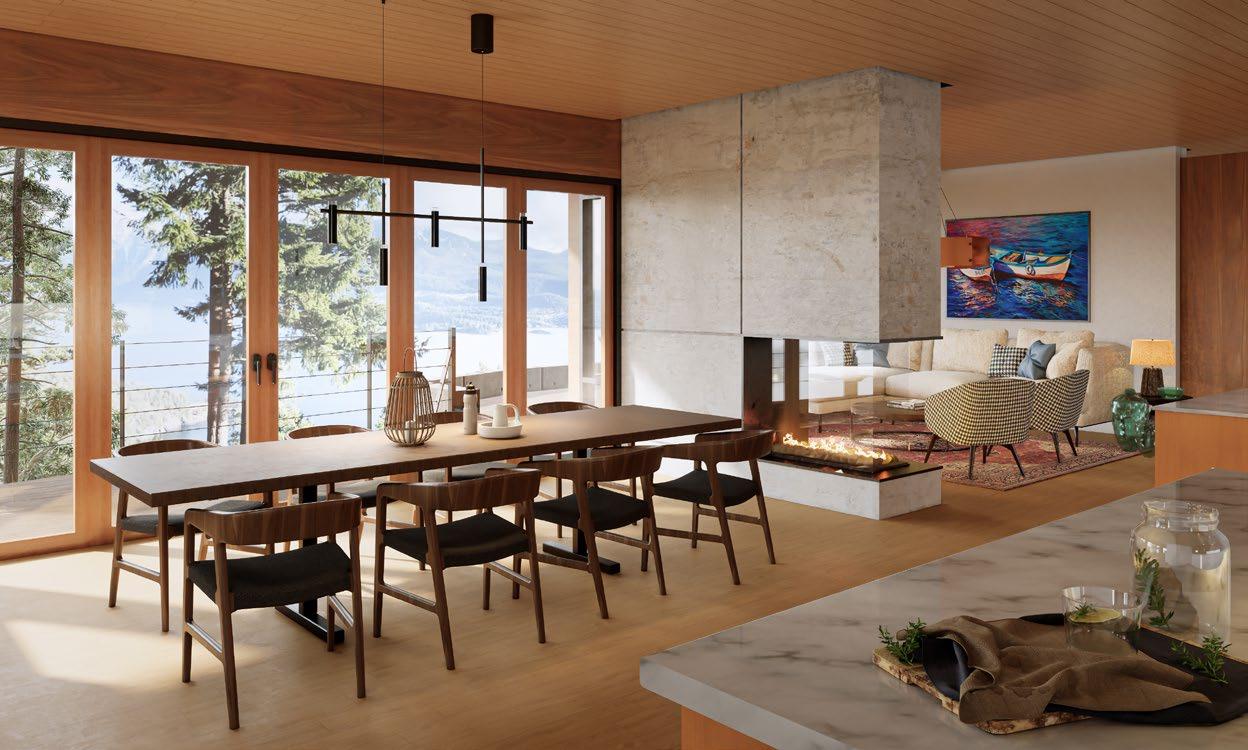
@Home on the Coast | 9
In his formative years on Bowen Island, James designed and oversaw the complete transformation of the lower cove and was responsible for creating the master plan for the overall village redevelopment, which is just now nearing completion.
His many contributions to the community included designing a major addition to the historic ‘Old General Store, which houses the ‘Hearth Gallery’ and ‘Bowen Island Library’. He was also responsible for
the redesign and restoration of ‘ e First Credit Union Building’, A whole foods grocery store, as well as the ‘Bowen Island Pub’ and mixed-use complex.
Fast forward to March 2023 and James has relocated to the Sunshine Coast. is time to take up permanent residency in his latest project, a spectacular new landmark home overlooking the marina high on the bluff in Gibsons that he has just completed.

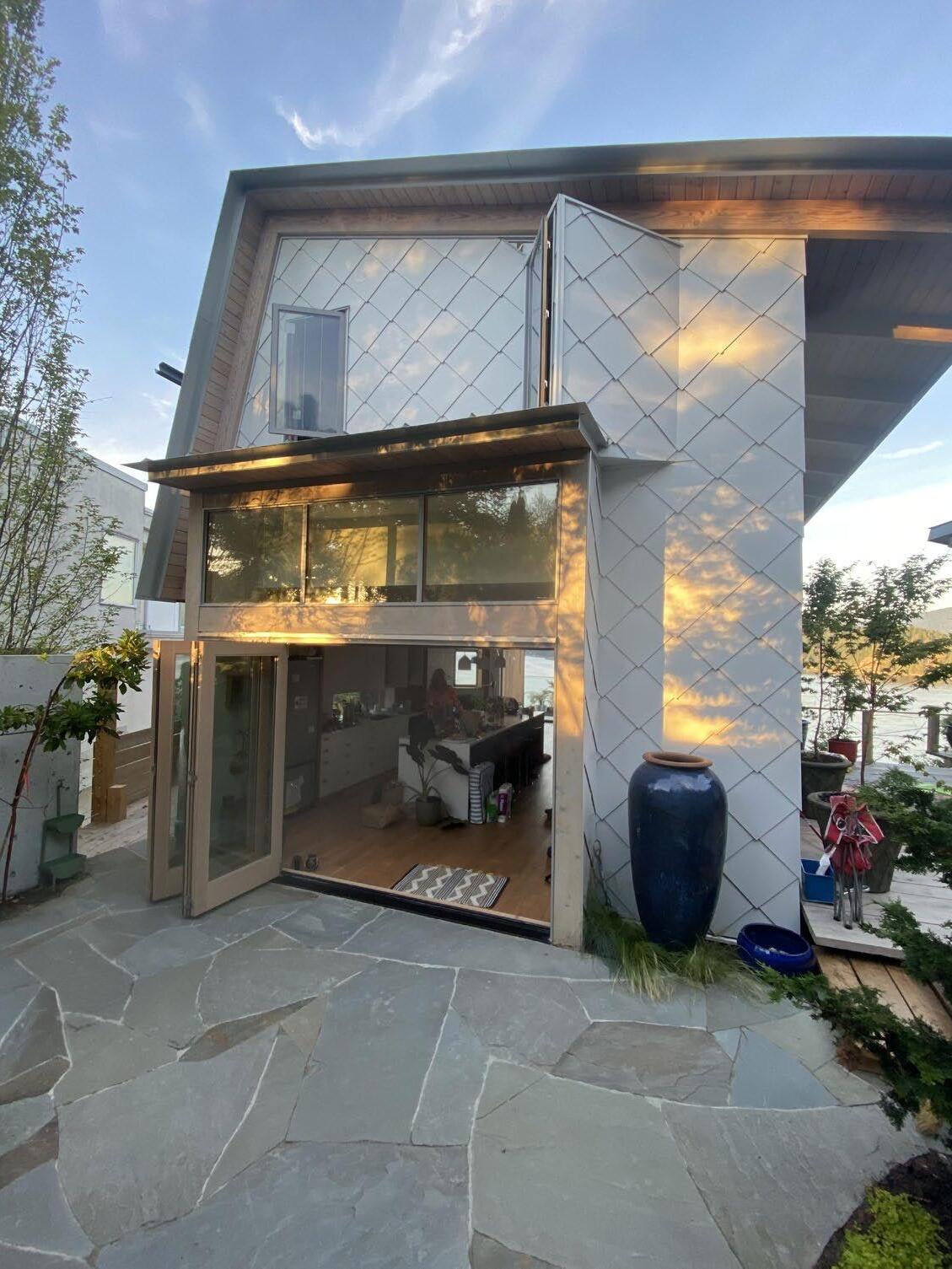
@Home on the Coast | 10








Sun - Wed 10am - 4pm • Thurs 10am - 8pm • Fri - Sat 10am - 5pm SHOP ONLINE 24-7 CURBSIDE PICK-UP AVAILABLE www.deluxelandscaping.com 604 885 9070 ACACIA HOMES NEW BUILDS RENOVATIONS MULTI-FAMILY CONSTRUCTION CONTACT US TODAY! 604-989-8743 info@acaciahomes.ca @Home on the Coast | 11
e challenges of designing and building a dream home on a difficult steep lot that had sat vacant for 60 years was nothing new to James. As this quote from that original article makes clear, James is no stranger to danger when it comes to challenging building sites.
“ James fi rst came to the coast in 1991 and purchased five acres of waterfront land in Narrows Inlet where he hand-built a rustic cedar cabin” e article goes on to say, “Over the years
James has designed and overseen the construction of some of the Sunshine Coast’s most unique and progressive homes. He embraces the challenge of working in this rugged coastal environment”


With the completion of his new home on Skyline Drive James skillfully navigated balancing a sense of privacy while embracing the spectacular views and creating usable outdoor space with easy access on a challenging property.


@Home on the Coast | 12
Currently, James is keeping busy designing several new homes, and in keeping with his practice of giving back to the community, has recently joined Habitat for Humanity’s Land & Resources Committee as a volunteer to help promote affordable housing options here on the Coast.
His current satellite projects include a family compound in Yosemite National Park and the five-star ‘Bliss Hotel’ with an adjacent post-secondary school for the hospitality industry.



James oversees JWT Design Ltd which in addition to offering architectural design services also specializes in high-end interiors, landscape architecture, planning and urban design.

@Home on the Coast | 13






@Home on the Coast | 14
Kitchen Design Trends For 2023 10
Find inspiration in new kitchen styles, materials, colors and features expected to take off this year.

(Revised courtesy of Houzz)
They say change is the only constant in life. Lately that notion feels all too true. But in an ever-changing world, many people are seeking stability — and joy — right at home. And in turn, a lot of homeowners are emerging from the last couple of trying years with renewed vigor for creating lively homes full of color, pattern, texture and optimism. To capture some of that energy, we’ve gathered a few design and remodeling trends that homeowners and pros are excited about for the coming year. See if any inspire a change to your own kitchen.
Modern Rustic Style
A few themes weave throughout these 2023 design trends. Among them are the use of natural materials and a general feeling of warmth. You’ll find both in a modern rustic style we’re seeing show up in kitchens. Think natural wood cabinets and other wood details paired with natural stone countertops and backsplashes, with a few modern elements thrown in.
Elegant Farmhouse Style
Another style showing up in kitchens is a more elegant take on the modern-farmhouse style that’s been popular in recent years. You’ll find many of the same elements, such as Shaker-style cabinets, apron-front sinks and furniturestyle islands and cabinets. But you’ll also notice the use of dramatic cabinet colors, oversize range hoods and slab stone backsplashes.
This kitchen exemplifies the style with a jet-black island and upper cabinets (Midnight Black by Benjamin Moore), turned island legs, Shaker-style rift-sawn white oak cabinets and quartzite countertops and slab backsplash.
Modern Spanish Style
Meanwhile, an updated approach to Spanish style is also taking hold. This kitchen is a good example of what it’s about. Terra-cotta floor tile, an arched range hood with a handpainted terra cotta tile backsplash and a custom island with an end-grain walnut butcher block counter and spindle leg detail update old-world style with a contemporary twist.

Warm and So Palettes
While some homeowners are desiring more bold color in their kitchens, many are looking for warm and soft styles that elicit a restful, relaxing atmosphere. To do that, designers are embracing greige or off-white cabinets, light woods, subtle patterns and warm bronze and brass finishes.
@Home on the Coast | 15

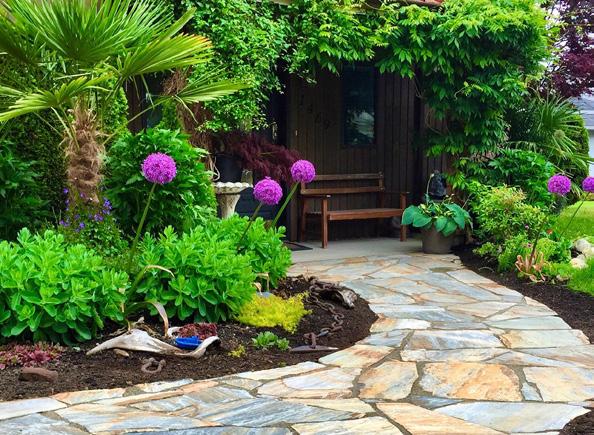

We are, licensed, insured & all employees are bonded. Scoka Gardens * design * hardscape/softscape installation * hedges - installation & maintenance * lawn installation, renovation & lawn cutting * artificial turf * redesign & revitalizing gardens * pruning - perennials, fruit & specimen trees * fences, pergolas * Allan Block certified * ICPI certified - pavers & flagstone * retaining walls & drainage * year round property maintenance scokagardens.com • 604-740-7770 • scott@scokagardens.com from installation to year round maintenance. WE ARE dedicated to the highest level of customer service and satisfaction. @Home on the Coast | 16
Natural Materials
Natural materials are always in style, but lately they seem to have hit a high point in popularity. In particular, homeowners are installing quartzite and other natural stone countertops, as well as marble tile and wood cabinets and vanities, especially white oak. Some designers say the surge of interest in natural materials is a result of some homeowners rethinking man-made materials like engineered quartz that have dominated homes in recent years and instead gravitating to natural materials that add character and authenticity to a space. Designers used 6-by-6-inch tumbled travertine in silver to add a natural element to this kitchen.
Blue Features
White and gray are the most popular colors used in kitchens. But when homeowners stray from that palette, they often choose blue. In fact, when a homeowner chooses to go with an island color that contrasts with the surrounding cabinets, more than a quarter (26%) will select blue, according to Houzz research.

For this kitchen the homeowners looked to photos to inspire the white palette with blue, including blue bar. A marble blacksplash behind the stove ads texture.

@Home on the Coast | 17
Wood cabinets are trending along with the surge in natural materials. White oak seems to be dominating the choices, but walnut is also popular. Designers gave this kitchen quartersawn white oak lower cabinets and a range hood detail to warmly balance out the white and creamy tones.
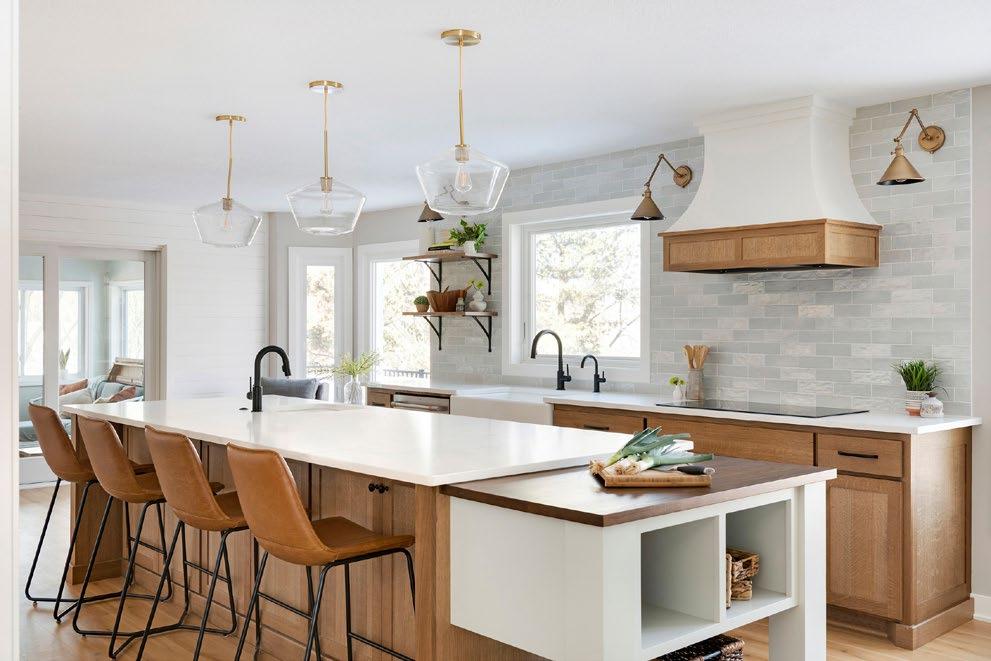
Creative Island Seating
Casual seating is just one of many appeals of a kitchen island. While the traditional seating arrangement has typically been a row of stools on one side facing the cooking area, some homeowners are seeking alternative setups to accommodate a variety of needs, such as the ability to sit face to face with guests or sit at a standard dining table height. As a result, we’re seeing a lot of islands with creative seating arrangements, such as two-tiered designs with seating for 10 and dropped-down or raised-up areas for various needs.
Commercial-Style Faucets
Many home chefs are gravitating to commercialstyle kitchen features to better tackle cooking tasks. In response, many faucet brands have launched new commercial-style faucet lines that blend industrial and modern looks, such as Belfi eld by Moen.
Workstation Sinks
Workstation sinks are also part of the drift toward commercial-style features. These have been around for many years now, but manufacturers have caught up to the demand and now offer all kinds of sizes, styles and accessories for things like chopping, straining, drying and other functions.

@Home on the Coast | 18
Wood Cabinets


®University Sprinklers and www.universitysprinklers.com are registered trademarks of University Sprinkler Systems Inc. GOLF Your Game in 2023? IS 604.885.2700 blueoceangolf.ca PHOTO CREDIT: mollymcphersonphotography.com MAY 1ST DISCOUNTED MEMBERSHIP PRICING OFFERED 2 WEEKS EARLY ON APRIL 15TH • $2400 - 18 Hole • $2300 - 18 Hole Couple (ea). • $1600 - 9 hole • $1450 - Twilight after 1pm • $170 - Junior 18 & under • $725 - $1575 Intermediate 19-34 • $175 - Advantage Club • or... Save with 5 Round Passes Pre-tax. Payment Plans available Prices above begin April 15th Blue Ocean Bar and Grill Reopens Wednesday March 15 @Home on the Coast | 19
6 Easy Steps to Prepare Your Garden for Spring

 by Angela Koops
by Angela Koops
Spring is a season that brings new life and hope after the cold winter months. It is the perfect time to prepare your garden for the upcoming season of growth and renewal. Preparing your garden for spring requires planning and preparation to ensure a bountiful harvest and a beautiful landscape. Here are some steps you can take to prepare your garden for spring:
Clean Up Your Garden:
The first step to prepare your garden for spring is to clean up any debris and dead plants left over from the winter. Remove any weeds, leaves, and fallen branches. These can be a breeding ground for pests and disease. Remove any debris from the garden beds, and prune any shrubs and trees as needed. This will not only make your garden look neat and tidy but also help to improve the health of your plants.
Soil Preparation:
The next step is to prepare your soil for spring. The soil in your garden bed should be loose, aerated, and nutrient-rich to support healthy plant growth. To achieve this, start by removing any weeds and debris from the soil. Then add compost or wellrotted manure to improve soil structure and fertility. Loosen the soil with a garden fork or tiller to improve aeration and drainage. You can also add organic matter like leaves or grass clippings to improve the soil structure and fertility.

@Home on the Coast | 20








VEGGIE MIX a blend of compost and manure. $5800 / YARD GARDEN MIX $6000 / YARD SOIL STARTING AT $60 A YARD Garden Mix | Turf Blend | Mushroom Manure | Fir Bark Mulch No dead diseased farm fish is in our soil. No biosolids. Our soil is made of recycled green waste. Our soil meets BC Landscape Specs 604.740.7715 CALL US TODAY! TOP SOIL POT TILAUQ Y Simply The Best Custom Blended Soils Since 1988 Proud Supplier to the Sunshine Coast Botanical Society and 40+ Contractors Garden Mix | Turf Blend | Mushroom Manure | Fir Bark Mulch No dead diseased farm fish is in our soil. No biosolids. Our soil is made of recycled green waste. Our soil meets BC Landscape Specs 604.740.7715 CALL US TODAY! TOP SOIL TOP QUALIT Y Simply The Best Custom Blended Soils Since 1988 Proud Supplier to the Sunshine Coast Botanical Society and 40+ Contractors Garden Mix | Turf Blend | Mushroom Manure | Fir Bark Mulch No dead diseased farm fish is in our soil. No biosolids. Our soil is made of recycled green waste. Our soil meets BC Landscape Specs 604.740.7715 CALL US TODAY! TOP SOIL TOP QUALIT Y Simply The Best Custom Blended Soils Since 1988 Proud Supplier to the Sunshine Coast Botanical Society and 40+ Contractors Garden Mix | Turf Blend | Mushroom Manure | Fir Bark Mulch No dead diseased farm fish is in our soil. No biosolids. Our soil is made of recycled green waste. Our soil meets BC Landscape Specs 604.740.7715 CALL US TODAY! TOP SOIL TOP QUALIT Y Simply The Best Custom Blended Soils Since 1988 Proud Supplier to the Sunshine Coast Botanical Society and 40+ Contractors @Home on the Coast | 21

TANDEM DUMP TRUCKS, TRIDEM PUP TRAILERS, EQUIPMENT MOVING, SAND & GRAVEL DELIVERIES toprocktruck@gmail.com 604-989-0617 @toprocktrucking @Home on the Coast | 22
your plants deeply and regularly, especially during dry spells. Watering in the early morning or late afternoon when the sun is less intense will reduce water loss through evaporation.

Pest and Disease Control:

Pests and diseases can be a significant problem for gardens, but they can be controlled with proper care. Use organic pest control methods like neem oil or insecticidal soap to control pests. Keep an eye on your plants for signs of disease and treat them immediately with organic fungicides. Removing any infected plant parts will also help to prevent the spread of disease.
Planting:
Spring is a great time to start planting in your garden. Choose the plants you want to grow and order them early. Start with cool-season vegetables and flowers like peas, radishes, lettuce, and pansies. These can tolerate cooler temperatures and can be planted as soon as the soil is workable. You can also start seeds indoors and transplant them into your garden when the weather warms up.
Mulching:
Mulching your garden can help to improve soil health, reduce weeds, and conserve water. After planting, cover the soil with a layer of organic mulch like straw, shredded leaves, or wood chips. This will help to retain moisture in the soil, reduce erosion, and keep the soil cool during hot weather.

Watering:
Watering is an essential part of garden care, especially in the spring when plants are actively growing. Make sure to water
Preparing your garden for spring requires planning and preparation. Cleaning up your garden, preparing your soil, planting, mulching, watering, and pest and disease control are all essential steps in creating a beautiful and productive garden. By following these steps, you can ensure a bountiful harvest and a stunning landscape that will be the envy of your neighbors.
@Home on the Coast | 23
Living in the Future
The future of housing is an exciting topic with many advancements on the horizon. The way we live, work, and play is constantly evolving, and the same is true for how we design and build our homes. As technology continues to advance and urban populations grow, housing options are becoming more sophisticated and innovative. In this article, we will explore some of the most exciting advanced housing options in the future.
1
Smart Homes: Smart homes are already becoming more common, but in the future, they will be even more advanced. With the advent of artificial intelligence, homes will be able to anticipate their owner’s needs, adjust to their preferences, and provide personalized experiences. Imagine a home that can automatically adjust the temperature, lighting, and sound based on your mood, schedule, and habits. This is the future of smart homes.

2
3
Modular Housing: Modular housing is an innovative building technique that allows for faster construction and more affordable homes. In the future, modular homes will become even more advanced, with designs that are both flexible and customizable. Homeowners will be able to create their dream home, choosing from a variety of pre-designed modules, and then assembling them on site.
Co-Living Spaces: Co-living spaces are shared living environments that are gaining popularity among urban millennials. In the future, coliving spaces will become more sophisticated and luxurious, with high-end amenities and services. These spaces will be designed to foster community and social interaction, offering a new way of living for those who value connection and collaboration.
4 Vertical Gardens: As urban populations grow, green spaces become more limited. In response, architects and builders are exploring ways to incorporate greenery into high-rise buildings. Vertical gardens are one way to accomplish this. These gardens are designed to grow vertically up the side of a building, providing a beautiful and sustainable living environment.
5 3D Printed Homes: 3D printing is revolutionizing the construction industry, allowing for faster and more affordable building methods. In the future, 3D printed homes will become more advanced and sophisticated, with designs that are both functional and beautiful. These homes will be able to be printed on-site, reducing construction time and minimizing waste.
6 Off-Grid Living: Off-grid living is a growing trend among those who value sustainability and selfsufficiency. In the future, off-grid homes will become even more advanced, with technologies that allow for greater energy efficiency, water conservation, and waste reduction. These homes will be designed to operate independently of the grid, providing a selfsustaining and environmentally friendly living environment.
In conclusion, the future of housing is full of exciting possibilities. From smart homes to modular housing, co-living spaces, vertical gardens, 3D printed homes, and off-grid living, there are many advanced housing options on the horizon. As technology continues to evolve, we can expect to see even more innovative designs and building techniques that will revolutionize the way we live. Whether you are looking for a sustainable, self-sufficient home or a luxurious co-living space, the future of housing has something for everyone.

@Home on the Coast | 24







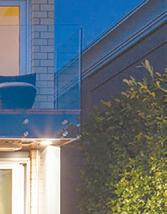

A local, family run disposal bin service, covering the entire Sunshine Coast and Islands. t bin r e n t a l s • Bins ranging in size from small 2 yard bins to large 50 yard bins and many in between • With 3 di erent sizes of trucks,we can t into any spot and handle the largest loads • No job too big, no job too small • Good for all projects: new construction, renovations, demolition, house and yard renovations, rock and concrete, drywall, roo ng or anything else Sunshine Coast ’s Waste Removal Specialists SHIPPING CONTAINER & PERIMETER FENCE RENTALS AVAILABLE 604-740-2749 • coastbinrentals.ca Call Tyler for a quote today Your local window factory years of making windows in Powell River BC 35 Improve your home this year with Modern windows and doors Get your quote today 604.989.0341 jamesf@modern.ca modern.ca @Home on the Coast | 25








Quality Construction Materials for the SUNSHINE Coast STOCKWELL GROUP OF COMPANIES www.centralcoastconcrete.ca READY-MIX @Home on the Coast | 26
INrecentyears, modular or factory-built homes have become an increasingly popular option for those looking to build a new home on the Sunshine Coast.
ese homes o er numerous advantages over traditional stick-built homes, including cost-e ectiveness, time e ciency, and energy e ciency.
One of the most signi cant advantages of modular or factory-built homes is their cost-e ectiveness. Since these homes are built in a factory and assembled on-site, they require less labour and materials than traditional homes. is means that modular homes can o en be built at a much lower cost than stick-built homes. is is particularly appealing for those who are looking to build a home on a budget, or who are simply looking to get
Modular Homes: e Future is Here
the most bang for their buck. Another advantage of modular or factorybuilt homes is their time e ciency. Since these homes are built in a controlled environment in a factory, there are fewer delays due to weather or other external factors. Additionally, the assembly of the home on site is typically much quicker than the construction of a traditional stick-built home. is means that modular or factory-built homes can o en be completed in a matter of weeks, rather than months or even years.
Finally, modular or factory-built homes o er signi cant energy e ciency advantages. ese homes are typically built with energy-e cient materials and systems, such as double-paned windows, high-e ciency HVAC systems, and insulation that exceeds building code requirements. is means that modular

homes are typically much more energye cient than traditional homes, which can translate into signi cant cost savings on energy bills over time.
In addition to these advantages, modular or factory-built homes also o er a wide range of customization options. From oor plans to nishes, homeowners can choose from a variety of options to create a home that meets their unique needs and preferences.
Overall, modular or factory-built homes o er numerous advantages for those looking to build a new home. From coste ectiveness to energy e ciency, these homes o er a modern and practical option for those who want to build a beautiful and functional home in a shorter amount of time and at a lower cost than traditional stick-built homes.
@Home on the Coast | 27
CRIME. POVERTY HUNGER. HOMELESSNESS.
Together we make change.
Sunshine Coast Community Services is raising much-needed funds to develop a long-term and sustainable solution to help address poverty, homelessness, hunger and crime. The Building Together development will include 34 units of affordable housing, crisis response, support and prevention programs - all in one location. These resources will be accessible to all Sunshine Coast community members and will play a critical role in the health and wellbeing of our entire community.
Please donate. Your donation today will help us build a healthy and thriving Coast for all.

Thursday ThrOugh MOnday, 11aM - 4pM Free adMissiOn and parking gpag.ca 431 Marine drive, gibsOns arT is FOr everyOne! JOin us. Inspiring exhibitions and local artisan gift shop. Fun volunteer opportunities and GPAG member benefits. @Home on the Coast | 28
Open
A ordable Housing Solutions Begin at Home
Itwas encouraging to hear in the last election how many candidates campaigned for more housing and won seats last election. It’s now time we all should expect to start seeing dramatic changes in the way that municipalities plan and approve housing. Recent Provincial announcements and focus on housing won’t make a di erence unless we make changes at the local level of government.
e housing crisis has a lot to do with inadequate municipal urban planning, lack of political action, the disintegration of Globalization, and easy access to cheap credit which have driven up asset values. ese factors have led to a signi cant increase in home prices making home ownership unattainable for most Canadians.
To achieve a ordable housing in Canada, the Canada Mortgage and Housing Corporation (CMHC) estimates that over 3.5 million new homes must be built by 2030. In British Columbia, CMHC ags 570,000 new homes required by 2030, however this calculation is based on no additional immigration to the province over that time.
What can be done? Build a lot more housing. At a high level, more supply means lower prices and therefore a ordability. It requires a new contract in the relationship between existing and potential future residents who need a voice and seat at the planning table. It requires acknowledging the shi from a static, holiday destination, never changing Sunshine Coast, to a region that is growing, evolving, changing.
To increase housing supply in B.C., the recommendations of the 2021 joint BCCanada Expert Panel report “Opening Doors” can be implemented. Changing municipal (Regional Districts, Districts, Cities, and Towns) and planning practices and removing regulations that increase the cost of new housing will also help. e Province should set clear new housing targets for the municipalities and be prepared to take over the planning functions from municipalities are politically unwilling to provide an
adequate supply of new housing. A study by the C.D. Howe Institute in 2020 found that housing supply restrictions in B.C. increases home prices by an average of $230,000.
e good news is that our municipalities also have the tools to address the housing crisis. Immediate actions and solutions that they can undertaken include:
Modernize municipal planning by amending o cial plans to increase permitted densities by a signi cant amount to meet future demand, then ensure zoning by-laws are updated to match. is means ensuring that missing middle and all forms of housing are included.
Mandate development approval timelines to ensure the process is e cient. Alberta and Ontario have strong systems for this that can be easily implemented where approvals are talked about in weeks, not years. Municipal leaders should also prioritize a ordable housing projects over concerns of NIMBYism (Not in my backyard), as research conducted by Habitat for Humanity the 2022 A ordable Housing in Canada Survey, shows that 63% of Canadians believe municipalities need to do more to combat this issue. To counteract NIMBYism, municipalities need to engage the whole community in a positive process of integrating a ordable housing solutions into the realities of their speci c locale.
Minimum density requirements should be established to increase housing supply and reduce problematic development standards such as minimum lot size, setback, landscape areas, parking, and building height. It is also important to restrict the municipality’s ability to comment on architectural matters, such as building design, to only quali ed advisors.
Fees and charges need to be lower, clear, and pre-established. Growth should pay for growth, but no more. Government fees, costs, and taxes add 20-30% to the cost of a new home, according to the Canada Mortgage and Housing Corporation (CMHC). Building Permit Fees levied on all new construction should be based on cost recovery and not
used as a source of unearned municipal revenue. Fees and charges should be directly and transparently tied to growth-related infrastructure improvements.
Community Amenity Contributions should be restricted or eliminated. Community Amenity Contributions (“CAC’s”), which involve municipalities negotiating and granting extra density to developers in exchange for nancial compensation or community amenities, may lead to con icts of interest such as arti cially low planning density to gain greater CAC payouts. Housing density should be properly planned from the Regional Growth Plans down to zoning bylaws. Research indicates that levying CAC’s reduce land available for development, restricting supply and increasing housing costs.
Municipalities need to prioritize housing a ordability by removing requirements that increase building costs. is includes avoiding costly decisions and requires, such as banning natural gas from new construction, or requiring extra parking, or having bylaws that restrict e cient use of land and higher housing density, such as onerous tree preservation bylaws that are weaponized to obstruct housing.
While this list is not exhaustive, if municipalities enacted these along with recommendations in the Opening Doors report, we’d be o to a good start. As advocates for a ordable housing on the Sunshine Coast, we can work towards solutions by encouraging our elected o cials to act as promised.
Douglas Dunn is Executive Director of Habitat for Humanity Sunshine Coast and a business and non-pro t development expert. He has been involved in high-tech, social services, and charitable sectors for over 40 years.
is article is based on the work of Scott Dutchak. Scott is the CEO of Habitat for Humanity Victoria and a professional urban planner. His previous roles include the head of real estate, sustainability, and environment for TELUS as well as heading BCIMC’s real estate development investment portfolio.
@Home on the Coast | 29
Sunshine Coast Real Estate Snapshot




So far in 2023, we have seen a small jump in our local market! While all segments of the market are down from last year at this time it was not unexpected. e Real Estate Board of Greater Vancouver’s economist, Andrew Lis, forecasts the market will look a lot like last year.

e takeaway is that peak pricing was last spring and the market has come down since then and prices will, due to the lack of inventory, remain where they are over the next year. Additionally, we have heard from the Bank of Canada that “as long as the signs of continued in ation ease” they will pause the rate at the previous increase of .25%.
During the last two months of 2022 and the rst months of 2023 we have seen that buyers are simply waiting to hear the right signals to move forward with a purchase, meaning that while sales are low, demand for real estate on the Sunshine Coast continues to be strong. erefore, this demand is becoming pent up and we will likely see a short-term rush on purchases over the next quarter and then a more balanced market moving forward.


Whether you’re buying, selling or simply making plans give us a ring for market intelligence and a strategic plan to move forward with your real estate goals. Call Coast Lifestyles Network today. Russ 604-741-7119

101 - 93 8 Gibson s Way, Gibson s BC V0 N 1V 9 www.coastlifestyles.ca Fa c e bo o k: Coa s t L i fe s t yl e s N e t wo rk o f f i c e 6 0 4 - 8 8 6 -2670 R u s s Q u re s h i Jon McRae PREC 604-741-7119 russ@coastlifestyles.ca 604-740-6263 jon@coastlifestyles.ca Two storey Master on the main 1671 sqft 3 beds / 2 bathrooms Beautiful upgrades Corner Lot Steps to the tennis court Asking TBA Call us to preview! Coming Soon www.parklandgibsons.ca
1043 Goddard Road - Gibsons
@Home on the Coast | 30







SOLAR POWER FOR INDUSTRY, HOME & VEHICLE S OL A R B C! G O GoSolarBC .com GoSolar B C .com BC’S LARGEST SOLAR INSTALLATION COMPANY! Alternative Power Systems SAVE MONEY. SAVE THE PLANET. E L E C T R I C O L S O N O L T D A D I V I S I O N O F S U N S H I N E C OA S T • LOW E R M A I N L A N D • F R A S E R VA L L E Y THE OLSON GROUP OF COMPANIES NE C HI O S A N S U T S Fire Protection Di d v t i L si c o i n ctr o e f O E so O L S O N E L E C T R I C L T D E L E C T R I C Alternative Power Systems RENOVATING OR BUILDING NEW? Talk to us now! ASK US ABOUT LEVEL 2 EV CHARGERS! Call Today for an On-Site Evaluation 604.885.0599 • 1.855.888.0599 CLEAN, RENEWABLE, AFFORDABLE ENERGY TSBC Licence # LEL0014301 604-885-8889 Toll Free: 1-877-299-9492 1945 Field Rd. Wilson Creek VISIT OUR WEBSITE! WWW.SUNCOBUILDING.COM SUNco BUILDING MATERIALS LTD. Visit Our Warehouse Showroom with Your Measurements! 100’S IN STOCK • ALL SIZES& STYLES• GREAT PRICES CASH & CARRY or WE INSTALL! • FREE ESTIMATES We are the Sunshine Coastʼs #1 Source for & DOORS WINDOWS ALSO CUSTOM DOORS, WINDOWS & GLASS! @Home on the Coast | 31

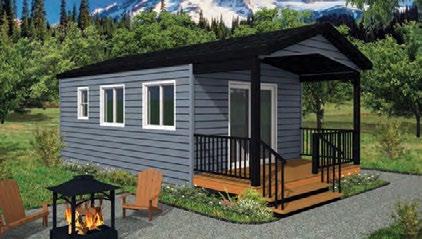








Elkhorn 308 SQFT $97,000 Baker 364 SQFT Robson 448 SQFT $106,000 $121,000 Fairmont 532 SQFT Blackcomb 532 SQFT $125,000 $125,000 Garibaldi 308 SQFT $99,000 Cabins Residences Laneway Homes www.EcoFab.ca • 604 989-8184 ecofabmodular













































































 by Angela Koops
by Angela Koops


















































